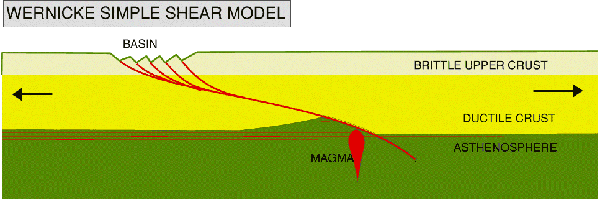|
Extension of stable continental lithosphere: Conceptual models |
|
|
| As the lithosphere stretches during continental extension, the deeper crust thins by ductile deformation, while the upper crust is broken up and pulled apart by listric faults which 'bottom out' in the ductile layer. A sedimentary basin develop at the surface. It gradually filled up with syn-rift shallow to deep water sediment as its bottom subside. Overall the deformation of the lithosphere is symmetric. This is the essence of McKenzie-type models of basin formation. As the lithospheric mantle is thinned by stretching it is replaced by hotter asthenosphere. Following extension and thinning the lithosphere gradually cools on a time scale of 50 - 100 Myr. As it cools it becomes denser and the sedimentary basin above gradually subsides and is progressively filled with post-rift shallow-water sediments. The amount of subsidence depends on the initial amount of stretching. Note that subsidence occurs in two stages: (1) as a result of tectonic stretching – on a short time scale, (ca. 10 Myr), and (2) as a result of thermal subsidence – long time scale, (ca. 50 -100 Myr). |
|
|
|
 |
|
|
|
Another model been proposed by Wernicke (the two models below). The important difference is in that stretching is accommodated by a single low-angle detachments fault which produces a strong asymmetry. Basins associated with the thermal subsidence phase may be offset from the basins associated with the initial rifting. Volcanism (melting resulting from the uprising asthenosphere) may be offset from the main sedimentary basin. Because of the asymmetry, the continental margins on the two sides of an opening ocean may have very different profiles. |
|
|
 |
|
|
 |
|
|
|
|
|
|
|
|
|
|